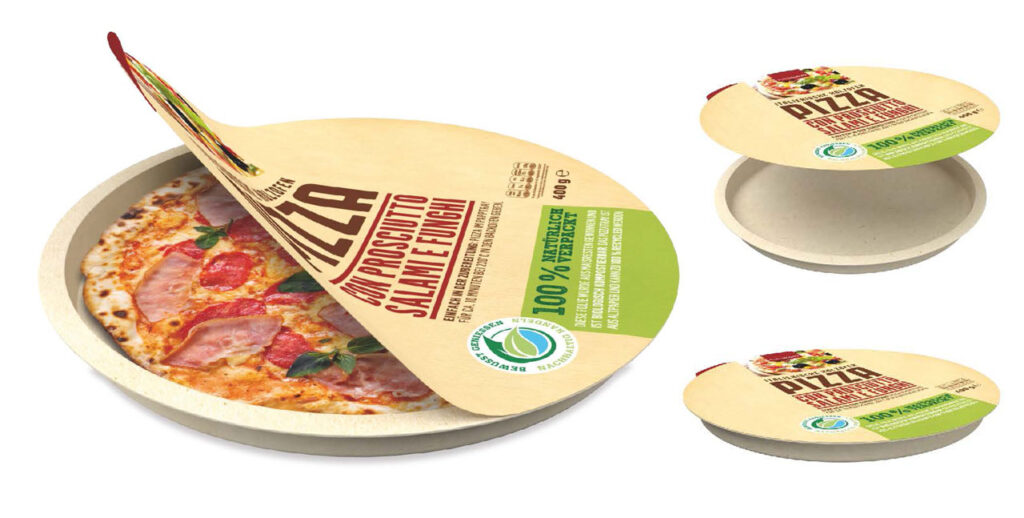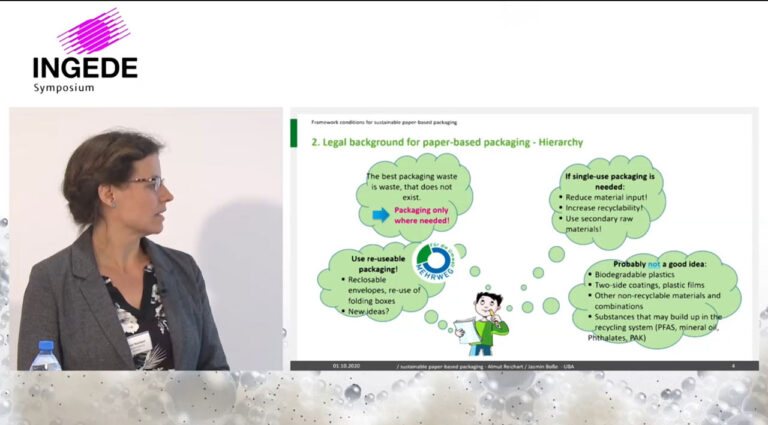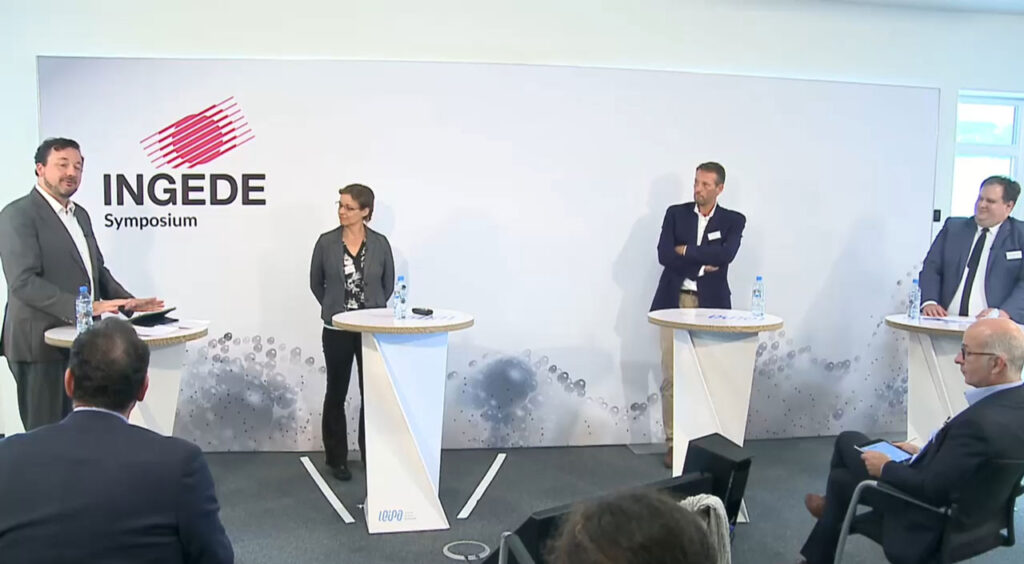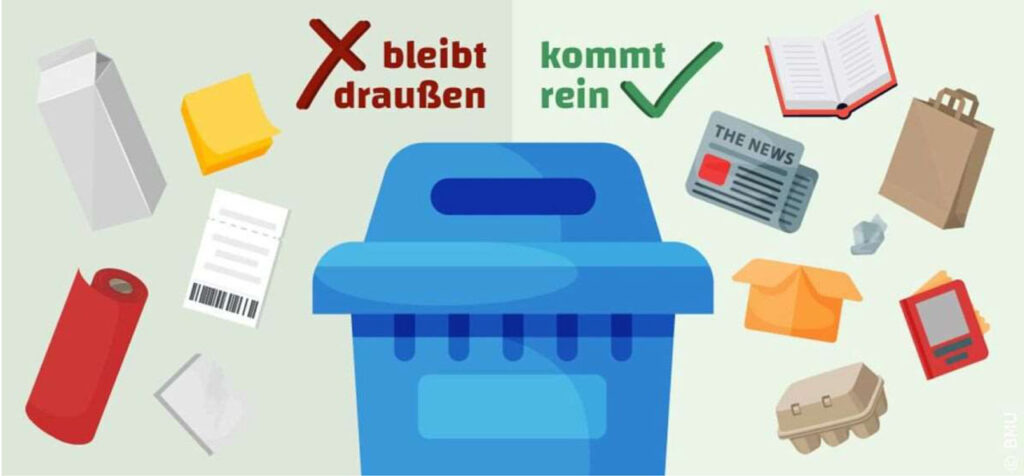Press Release 1/2020
Can paper replace plastic? Packaging design in the fibre loop
European solutions are necessary for the evaluation of packaging recyclability
INGEDE Autumn Symposium on October 1, 2020, at Leipa in Schwedt
Frozen pizza in a round paper tear-open pack, beer in a bottle made of fibre? Is this the future of packaging, fibre-based protection for food instead of plastic? At the INGEDE Autumn Symposium in Schwedt, experts from industry, authorities, and associations discussed possibilities to replace plastic which has fallen into disfavour due to lack of material recycling, the conditions for good recyclability and the limits. The speakers largely agreed: There is a need for action for new paper-based packaging with regard to the general conditions, consumer information, and labelling; as well as for the further development of sorting systems and disposal routes. Instead of national ideas, European solutions are needed in the evaluation of packaging and its suitability for different recycling systems.
Paper, cardboard, paperboard – in terms of sustainability, they are the leaders in Germany with 89 per cent of the material and more than ten per cent of energy being recovered, all that based on a renewable raw material. However, too much potentially recyclable paper still ends up in packaging waste and residual waste, complained Robin Huesmann, CIO of the symposium’s host LEIPA Group. In Schwedt, papers with the Blue Angel and other environmental labels are produced from 100 percent recovered paper. Huesmann noted a lack of information for consumers, but also often a lack of willingness to separate. Uncertainty also plays a role here: What do I do with the waxed wrapping paper, what about the water-repellent deep-freeze packaging? Is this paper for recycling?
Even if paper is currently in demand as a packaging material – it does not always work as a barrier sufficiently. “The devil is in the detail here,” says Bernd Büsing, head of packaging at Nestlé Germany. Nestlé has developed “high-barrier papers” for several products, papers which contain up to ten percent of a polymer dispersion as a coating. Is this a paper or a composite? Or a grey area? In Germany, in France? Büsing does not want to see such packaging being marked “plastic free”. But the goal is: “We want to go into the blue bin.” Therefore, he welcomed the intensified exchange between packers and the recycling paper industry, which was intensified by the INGEDE event.
Ten percent polymers in paper are “not advantageous from our point of view”, confirmed Almut Reichart, environmental engineer and at the German Environment Agency (UBA) responsible for the pulp and paper industry. Avoiding packaging is always the authority’s top priority. She warned against an undifferentiated turning away from plastic: “Does paper still make sense when properties are required that paper cannot provide? Perhaps a plastic film would be the better material after all, if it was then disposed of or recycled properly? Reichart certainly sees a need for adaptation in the methods and standards for assessing recyclability. Not only manufacturers and associations, but also the authorities and in particular the Central Packaging Register must play a role here, said Reichart. “I can see that we have to perform our monitoring function more strongly here.”
Where is the used packaging being dumped?
How is it recycled?
Peter Désilets of Pacoon also pointed out the current great differences in the collection of packaging in Europe. His Munich-based agency focuses on the development of sustainable packaging and packaging strategies. Depending on the market and region, it is necessary to consider whether and how packaging is actually recycled, collected, composted, or otherwise recovered locally. The manufacturers of fibre packaging and the recyclers are also called upon to establish recycling standards at a higher level internationally. There are certainly possibilities to use intelligent combinations of plastic and fibres that can be easily separated again after use, as is already the case with some yoghurt cups.
Martin Drews of the German Pulp and Paper Association (VDP) clarified the position of the paper industry: The blue bin has proven its worth and should not only be protected, but ideally implemented throughout Europe. Maintaining a high fibre quality in the cycle “must be our goal”. Not everything that is made of paper can be recycled industrially – it is important to consider which colour, which varnish, or which coatings are associated with it. Ideally, barriers should be easy to separate from the fibres, either mechanically or manually by the consumer. Drews also drew attention to the yellow bin: This must be the way forward for new types of packaging that cannot be recycled in the main stream of paper for recycling. For this purpose, new recycling methods have to be considered. He warned against individual packaging manufacturers pushing ahead with new systems before their recycling had been clarified: “This creates confusion among consumers and hinders acceptance.”
Uniform methods necessary –
paper industry engages in research
Prof. Samuel Schabel from the Institute for Paper Technology at TU Darmstadt also complained about the large number of new developments, where it is difficult to keep an overview. Together with other partners, including the Papiertechnische Stiftung (PTS), Darmstadt is looking for a uniform evaluation method for the recyclability of packaging. “In the medium term, we will need a further technical step in reprocessing,” Schabel feared in view of the diversity of barrier materials. According to Tiemo Arndt of PTS, the INFOR-214 project aims to present “a presentable harmonised method” as a basis for discussion by November.
INGEDE – research for paper recycling
INGEDE is an association of leading European paper manufacturers founded in 1989. It aims at promoting utilisation of recovered graphic paper (newsprint, magazines and office paper) and improving the conditions for an extended use of recovered paper for the production of new graphic paper, hygiene paper, and white top liner and folding boxboard. For that, the paper collected in the Blue Bin has to be sorted into separately recyclable grades in order to keep the white fibres in circulation. White packaging also represents a potential raw material for new, light-coloured papers.
October 9, 2020
INGEDE e. V. · Public Relations
Oetztaler Str 5 B
81373 München, Germany
Tel. +49 (89) 769 2332
info at ingede.com
![]() This press release is also available as pdf
This press release is also available as pdf





